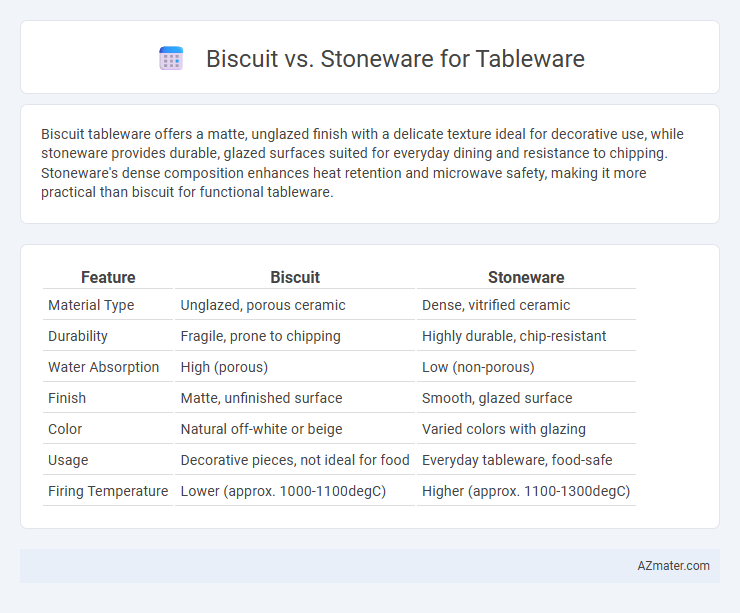Biscuit tableware offers a matte, unglazed finish with a delicate texture ideal for decorative use, while stoneware provides durable, glazed surfaces suited for everyday dining and resistance to chipping. Stoneware's dense composition enhances heat retention and microwave safety, making it more practical than biscuit for functional tableware.
Table of Comparison
| Feature | Biscuit | Stoneware |
|---|---|---|
| Material Type | Unglazed, porous ceramic | Dense, vitrified ceramic |
| Durability | Fragile, prone to chipping | Highly durable, chip-resistant |
| Water Absorption | High (porous) | Low (non-porous) |
| Finish | Matte, unfinished surface | Smooth, glazed surface |
| Color | Natural off-white or beige | Varied colors with glazing |
| Usage | Decorative pieces, not ideal for food | Everyday tableware, food-safe |
| Firing Temperature | Lower (approx. 1000-1100degC) | Higher (approx. 1100-1300degC) |
Defining Biscuit and Stoneware Tableware
Biscuit tableware refers to unglazed, porous ceramic pieces that have been fired once, offering a matte finish and a raw, natural texture often used for decorative or sculptural purposes. Stoneware tableware consists of dense, vitrified ceramics fired at high temperatures, resulting in a durable, non-porous, and often glazed surface ideal for everyday dining. The key difference lies in biscuit's unfinished, absorbent nature versus stoneware's robust, sealed finish suited for functional tableware.
Key Material Differences Between Biscuit and Stoneware
Biscuit tableware is made from unglazed porcelain fired at high temperatures, resulting in a dense, matte finish that excels in fine detailing and delicate designs. Stoneware is a type of vitrified ceramic fired at a slightly lower temperature than porcelain, creating a more durable, chip-resistant surface with a glazed finish typically suited for everyday use. The key material difference lies in biscuit's porous, unglazed texture compared to stoneware's non-porous, glazed, and sturdier composition.
Manufacturing Processes: Biscuit vs Stoneware
Biscuit tableware undergoes an initial firing process at lower temperatures, resulting in a porous and unglazed surface that is ideal for decorating and painting, allowing intricate designs to be applied before final glazing. Stoneware, however, is fired at much higher temperatures, creating a dense, vitrified, and non-porous body that does not require glazing to achieve durability and strength. The manufacturing process of biscuit emphasizes meticulous surface preparation for decoration, while stoneware focuses on achieving a robust and chip-resistant final product through high-temperature firing.
Durability and Strength Comparison
Stoneware tableware offers superior durability and resistance to chipping compared to biscuit porcelain due to its dense, vitrified composition. Biscuit porcelain, while elegant with its unglazed matte finish, tends to be more fragile and prone to breakage from impact or thermal shock. Stoneware's robust nature makes it ideal for everyday use, combining strength with resistance to scratches and stains.
Aesthetic Appeal and Surface Texture
Biscuit tableware features an unglazed, matte surface that offers a soft, natural aesthetic ideal for rustic or minimalist settings, emphasizing tactile warmth and subtle texture variations. Stoneware presents a smooth, often glazed finish with a durable, slightly glossy surface that enhances color vibrancy and provides a sleek, polished look suitable for both casual and formal dining. The choice between biscuit and stoneware depends on the desired visual impact, with biscuit delivering organic charm and stoneware offering refined sophistication.
Suitability for Everyday Use
Biscuit porcelain, also known as bisque, offers a matte, unglazed surface that resists chipping but can be more prone to staining, making it suitable for careful everyday use. Stoneware boasts a durable, glazed finish that provides excellent resistance to scratches, chips, and stains, ideal for high-traffic daily tableware. For households seeking robust, low-maintenance options, stoneware is generally preferred due to its practical resilience and ease of cleaning.
Maintenance and Cleaning Considerations
Biscuit tableware, known for its unglazed, porous surface, requires careful handling and gentle cleaning with a soft brush or cloth to avoid damage and stains. Stoneware, featuring a glazed finish, offers superior resistance to scratches, stains, and moisture, allowing for easier cleaning with regular dishwashing techniques. When prioritizing maintenance, stoneware presents a more durable and low-maintenance option compared to the delicate nature of biscuit ceramics.
Heat Resistance and Functionality
Stoneware offers superior heat resistance compared to biscuit porcelain, making it ideal for everyday tableware that withstands high temperatures in ovens and microwaves. Biscuit porcelain, being unglazed, is more porous and fragile, limiting its functionality for direct heat exposure and frequent use. Stoneware's durability and thermal shock resistance ensure practical performance for serving hot dishes and repeated washing.
Environmental Impact and Sustainability
Biscuit tableware, fired without glaze, consumes less energy during production compared to stoneware, which requires higher firing temperatures and often includes a glaze layer made from additional raw materials. Stoneware is more durable and chip-resistant, extending its lifecycle and reducing waste over time, but its manufacturing process can produce more kiln emissions and resource use. Choosing between biscuit and stoneware involves balancing lower initial energy consumption with longer-term durability and resource efficiency to minimize overall environmental impact.
Choosing the Right Tableware for Your Needs
Biscuit tableware, known for its unglazed, matte finish, offers a delicate and refined aesthetic ideal for decorative use or light dining. Stoneware, characterized by its durability, resistance to chipping, and glazed surface, suits everyday use and heavy-duty tasks in both residential and commercial kitchens. Selecting between biscuit and stoneware depends on priorities such as durability, maintenance, and the desired look for your dining experience.

Infographic: Biscuit vs Stoneware for Tableware
 azmater.com
azmater.com